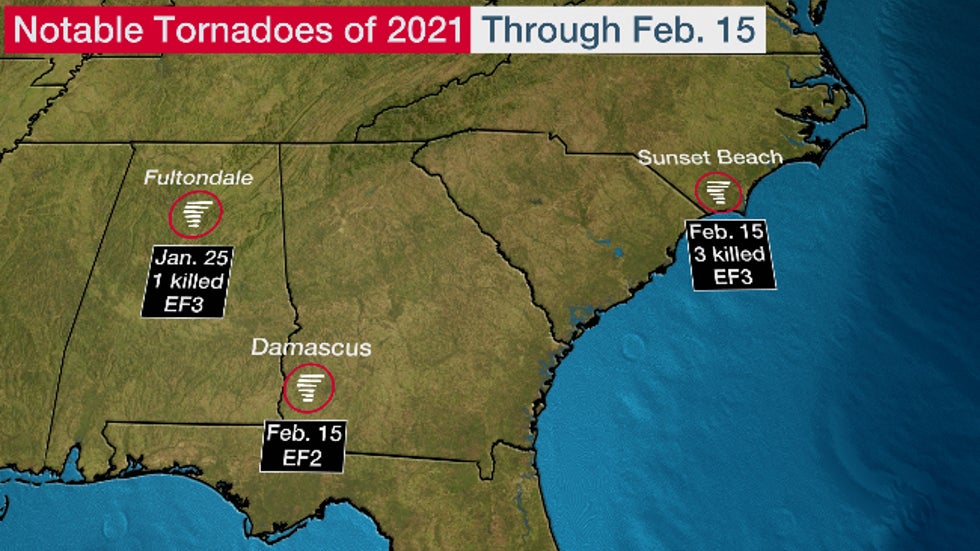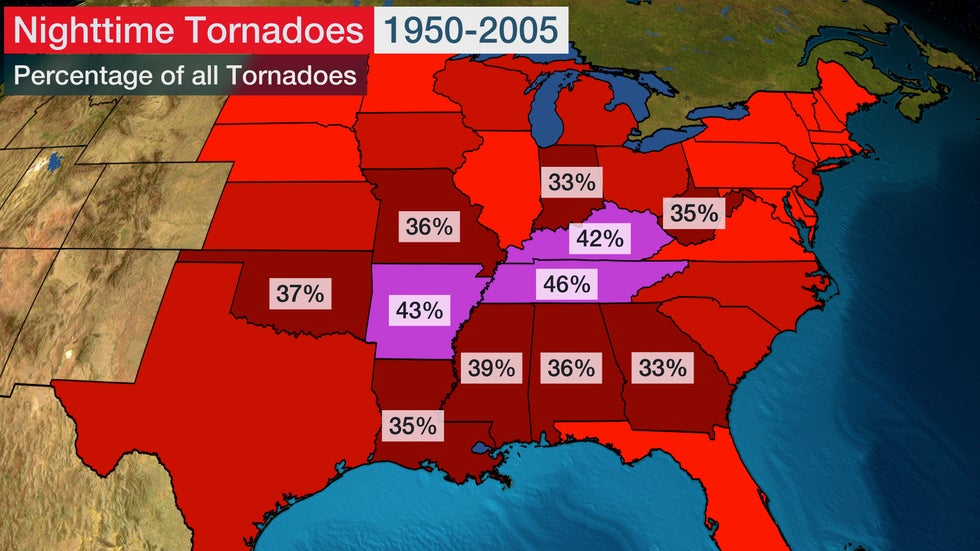Jonathan Erdman
There have already been two deadly tornadoes in the United States so far in 2021, both late at night, illustrating the danger even in weather conditions that do not support widespread severe weather outbreaks.
Late Monday night, a supercell thunderstorm spawned a tornado in Brunswick County, North Carolina, just before midnight.
Several homes were heavily damaged or destroyed by the EF3 tornado, which had maximum estimated winds of 160 mph, 6 mph shy of EF4 strength, according to the National Weather Service. Three people were killed and 10 others were injured.
Earlier that afternoon, the same weather system spawned an EF2 tornado near the southwestern Georgia town of Damascus. One house and one mobile home were heavily damaged.
Three weeks prior to that, another late-night EF3 tornado tore through Fultondale, Alabama, a northern suburb of Birmingham, on Jan. 25.
Among the damage, at least one home was swept off its foundation and debris from homes was thrown "considerable distances," according to the NWS damage survey. One person was killed by this tornado.
(FULL RECAP: How the Fultondale Tornado Happened)

There are several things can we take away from these seemingly isolated events.
It Doesn't Take an Outbreak
According to NOAA's Storm Prediction Center (SPC), there were only 34 total reports of severe weather – large hail, strong/damaging thunderstorm winds and tornadoes – on Feb. 15, the day of the North Carolina and southwestern Georgia tornadoes.
There were only 38 such severe reports in the Southeast on Jan. 25, the day of the Fultondale, Alabama, tornado.
In both cases, forecasters were not anticipating a widespread outbreak of severe thunderstorms. Such outbreaks often produce hundreds of severe weather reports, and can often spawn dozens of tornadoes, some of which are strong.
For Monday's forecast, the SPC initially forecast only a level 1 of 5 "marginal" risk for severe thunderstorms in eastern North Carolina and a level 2 of 5 "slight" risk in southwestern Georgia and northern Florida.
Later that morning, the SPC bumped the risk categories up a notch in each area, though they still weren't expecting a rash of severe thunderstorms.
 The Storm Prediction Center's severe weather outlook issued just after midnight on Feb. 15, 2021, had a level 2 of 5 "slight" risk of severe t-storms contoured in yellow over northern Florida and southern Georgia, and a level 1 of 5 "marginal" risk extending north to the coastal Carolinas. Reports of large hail (green), t-storm winds (blue) and tornadoes (red) are also plotted.
The Storm Prediction Center's severe weather outlook issued just after midnight on Feb. 15, 2021, had a level 2 of 5 "slight" risk of severe t-storms contoured in yellow over northern Florida and southern Georgia, and a level 1 of 5 "marginal" risk extending north to the coastal Carolinas. Reports of large hail (green), t-storm winds (blue) and tornadoes (red) are also plotted.Similarly in the Fultondale, Alabama, tornado case, initial SPC forecasts were only for "general" or non-severe thunderstorms over Fultondale, before they transitioned to level 1 risk.
So tornadoes are possible in even more marginal setups with relatively few severe weather reports, and sometimes these tornadoes can be stronger.
Nighttime Danger
Each of the two deadly tornadoes of 2021 struck between 10:30 p.m and midnight.
According to a recent study of about 48,000 tornadoes in the U.S. over a 56-year period, the odds of a nighttime tornado claiming at least one life are more than double that of one in the daytime.
And that's a particular problem in the South, where a significant fraction of all tornadoes occur at night.
(IN-DEPTH: The Danger of Nighttime Tornadoes)
 Percent of each state's tornadoes from 1950 through 2005 that occurred at night.
Percent of each state's tornadoes from 1950 through 2005 that occurred at night.Any Time of Year
Tornadoes can occur any time of the year conditions align.
In the South, that includes the months that are typically the depths of winter in much of the rest of the country.
While overall awareness of severe weather may not be as high during the winter months, in parts of the South, there really is no tornado season, per se – it lasts all 12 months.
While a siege of cold, snow and ice was plaguing parts of the Southern Plains, the same weather system spawned the North Carolina tornado on Feb. 15.
There can even be large outbreaks in winter. The February 2008 Super Tuesday Outbreak spawned 86 tornadoes over 10 states and claimed 57 lives.
 In the "possible" lighter red are locations that have a 0.1% probability of a tornado within 25 miles of a point by late February. The "most likely" darker red shading is for locations that have a 0.2% probability of a tornado within 25 miles of a point by late February, based on 1982-2011 averages.
In the "possible" lighter red are locations that have a 0.1% probability of a tornado within 25 miles of a point by late February. The "most likely" darker red shading is for locations that have a 0.2% probability of a tornado within 25 miles of a point by late February, based on 1982-2011 averages.What You Can Do
Here are some practical steps you can take to be ready ahead of the next severe weather threat.
-Before severe weather strikes, know where to seek shelter so you can get there quickly, even in the middle of the night. This is particularly important if you live in a mobile home. You probably will need to leave a mobile home for either a community storm shelter or another building.
-Take every forecast, watch or warning about severe weather seriously, particularly if it is forecast overnight. It only takes one tornado or severe thunderstorm capable of, for example, downing a tree on your home, to pose a danger.
-Have multiple ways to receive severe weather watches and warnings. This could include a NOAA weather radio or your smartphone, which can sound an alarm to wake you at night when a severe weather alert is issued for your area. These alerts could provide the precious minutes needed to move quickly to shelter and may save your life.
The Weather Company’s primary journalistic mission is to report on breaking weather news, the environment and the importance of science to our lives. This story does not necessarily represent the position of our parent company, IBM.
The Weather Company’s primary journalistic mission is to report on breaking weather news, the environment and the importance of science to our lives. This story does not necessarily represent the position of our parent company, IBM.

No comments:
Post a Comment